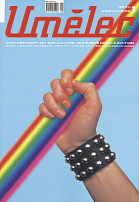| Umělec 2001/1 >> Minimalism and Space | Просмотр всех номеров | ||||||||||||
|
|||||||||||||
Minimalism and SpaceUmělec 2001/101.01.2001 Lenka Lindaurová | review | en cs |
|||||||||||||
|
Jan Stolín, 5.2m per second. Curated by Monika Mitášová, Pecka Gallery, Prague, 7 February – 16 March 2001
Though he’s not well known in Prague, Jan Stolín was right there in the trenches for last year’s Jindřich Chalupecký Award. Following a tight race, the award was spirited away by his more popular peer, David Černý, who, incidentally, was his classmate at Kurt Gebauer’s sculpture studio in the Applied Arts College in Prague. Already during his studies, Stolín was amazing critics with his excellent minimalist plywood objects. Not since the 1960s had anything so experimental been made in this field. His sculptures are characteristically smooth planed, with almost invisible depth. Often placed on the ground, they can give the impression of being some sort of ski-jump platform. Space is an even more essential aspect of Stolín’s art. He allows the placement and shape of his objects to be determined by the space in which his work is exhibited. The development of his spatial arrangements eventually evolved into the building of new walls that seemed to minimalistically empty the gallery. Almost invisible cracks in the walls, through which the outside world seeped, subtly changed the space’s quality of light and sound, with the walls physically responding to images like a camera obscura. This installation was first realized in the gallery Die Aktualität des schönen, Liberec, where he was gallery manager until local city officials converted it into office space. The wall theme is also inherent in his other interactive works, where a single movement can set in motion the clearly exposed ventilators behind the wall. Stolín has divided up exhibition spaces with minimalist objects, sounds and waves, silver air-conditioning conduits and beautiful objects that look like spatial lines. The conduits he has reserved for exterior projects. An installation in the finalists’ exhibition for the Jindřich Chalupecký Award in Veletržní Palace last year was able to combine all his recent themes, and he once again proved himself a successful manipulator of exhibition space. His Memorial in Liberec to Soldiers and Victims of the War for the Country’s Freedom, a curio among his work, was a wire construction containing tubes and digital displays with names. Once again he brought together interactive sound, visual elements and a flowing air stream. Stolín’s latest exhibition at the Pecka Gallery presented him as an ambitious multimedia artist who knew exactly how to unite minimalist means in order to create universal visual and sound arrangements worthy of John Cage. When he darkened the gallery entrance with large, blowing fans that “sang” into microphones and a looped video installation in which a hand continuously placed square objects one after another that would at short intervals disappear, his understanding of gallery space had never been more apparent. The ambivalence of this operation was made especially apparent by its placement in a short corridor, where the picture became incomprehensible as you approached. The demonstration of the inconspicuous causal relationships between two elements of the exhibition was tangential: The swirl of the fan might or might not be the cause for the objects falling in the video. Describing this kind of minimalism in words is precarious because in doing so one supports the condensing of unutterable spirituality (whose presence is often taken for granted) and the estheticism belonging to things drained down to their very essence. The artist then gives the impression of being rational and unsophisticated. Stolín’s projects, however, have nothing in common with elegant, Kolíbalesque artifacts. It is necessary to stress that his works are non-virtual multimedia sculptures stretching as far as viewers are willing to perceive them: from actual objects to a long gaze out the gallery window at the horizon with its many mysterious and incomprehensible objects. Translated by Vladan Šír Photo: Ondřej Polák and the artist
01.01.2001
Рекомендуемые статьи
|
|||||||||||||








Комментарии
Статья не была прокомментированаДобавить новый комментарий